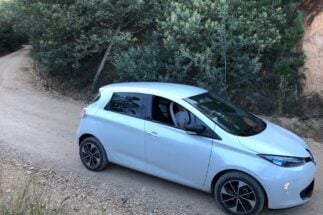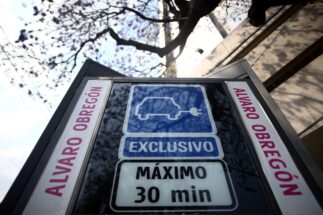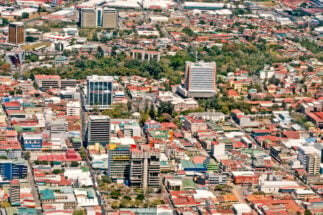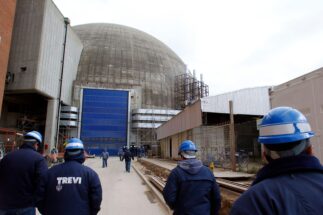In the last decade, increasing numbers of Latin American households have acquired electric cars. Although the region has not adopted the technology as fast as in Europe and the US, there have been notable year-on-year increases in electric vehicle (EV) ownership and in charging stations. Last year, 10,766 electric cars rolled through Latin America’s streets and the region’s charging network consisted of 1,292 public stations.
Currently, the transport sector is Latin America’s largest source of CO2 emissions. Private cars emit about 37% and trucks and public transport account for the rest. But changes in habits do not happen overnight and greater EV growth faces challenges in high prices and a lack of knowledge about the technology. Emilia Gempeler and Arturo Vélez, two Colombian doctors, bought an electric car in 2016 to make a positive contribution to the environment. They spoke to Diálogo Chino about the changes an EV has brought.
Diálogo Chino (DC): How did it all start, why did you buy an electric car?
Emilia Gempeler (EG):
Arturo and I were looking out for the moment when EVs arrived in Colombia because we wanted to lower our emissions into the atmosphere. We are aware of global warming and we think that each person can contribute something. I think that being divers and navigators, and also avid nature observers, makes us more aware of what is being lost and all that can be done.
Since [EV] technology is already invented, we wanted to stop consuming gasoline. So five years ago, when the Zoe Renault arrived, which had the best price, we bought it. We sold the SUV we had, and we just kept that one. Now we have the improved version of that same brand.
DC: What was it like to switch to an EV for the first time?
At first we adapted very quickly. [Electric cars] have a lot of spike when you accelerate and there is no period in which there is more injection of gasoline, so it is instantaneous. You accelerate and it starts like a rocket. So that is very pleasant to handle. It is quiet, you do not hear anything. From the beginning we were both fascinated.
When we go to the US to visit our daughter, we rent a gasoline car there. The electric ones are still very expensive to rent, even though the infrastructure is there.
DC: How does charging work?
EG: Here in Colombia they sell you the car with a wallbox, which is a charger that Codensa [the energy company] installs in your house. They install it in the parking lot with connection to the power of our apartment. We plug it in when we arrive in the afternoon and leave it plugged in overnight. It is much better because we never have to go to a gas station, there is no need to do maintenance or oil, all you have to do is pour water to clean the windshield.
We also have a cable that charges the car, and charges like any other appliance in the house. You can take that cable on a trip. You plug it into a normal socket and charge it.
DC: How long does it take to charge?
EG: In Bogotá it takes 4 hours to charge from zero to one hundred [percent full]. Here [outside the city] it takes 12 hours to be fully charged. The previous car with the battery charged 100% could travel up to 300kilometres. And with this it can go 400km. That’s a bit theoretical because when you just release the accelerator and step on the brake, the car charges itself, and the same when going downhill. In this country where you go up and down, it recharges itself.
In Bogotá there are several charging stations. There are some electric taxis in Bogotá, and they charge in stations in parking lots. In other places in Colombia there are stations, like in Medellín or big cities. In most mid-sized cities or small towns there are none.
DC: What other benefits do they have?
EG: They are exempt from Pico y Placa [ a Bogotá transport scheme that limits vehicle circulation at peak times]. They give us a big discount on insurance. Now they are trying to lower import duties and taxes. We don’t have to do the mechanical revision part. We have to check the brakes but not the engine.
The dealer has specialised places for these vehicles and the car itself advises when it is time to take it in. They check the mechanics and brakes and make sure the electronics are working well.
We also wonder what would happen if there were gasoline shortages in the city for some reason. With this car we don’t have to worry about that.

DC: How do you compare it in terms of costs?
EG: The previous SUV that we had cost us 100 million Colombian pesos [US$25,000]. This new car cost us 120 million [$34,000] pesos and it is not an SUV. But for us it works perfectly fine. Savings are made in everyday use. A tank of gasoline cost us 120,000 pesos [$34]. That’s 360 pesos [$102] a month on gasoline alone. For every time we charge it completely, it’s around 40,000 pesos [$10] and we charge it three times a month, so it’s 120,000 [$30] monthly and there’s no oil change or any other cost besides this.
DC: Do you know more people who own an electric car?
EG: Arturo’s sister-in-law’s father has one. We know people, but not very many. Because people still complain a lot. They don’t know them, they don’t know the advantages. A friend says that he misses the noise. But I think that most people don’t get them due to being unfamiliar and because it still seems very expensive to them.









